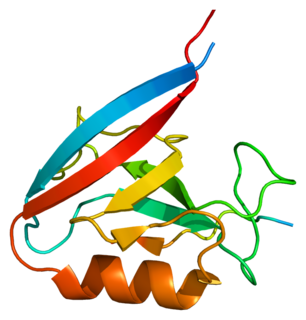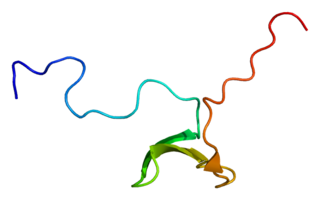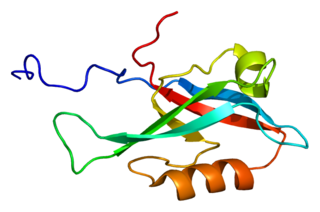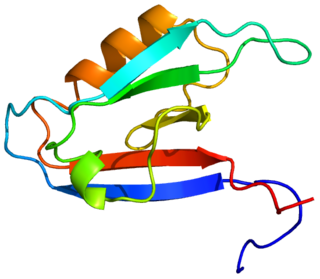Amyloid beta A4 precursor protein-binding family A member 1 is a protein that in humans is encoded by the APBA1 gene. [5] [6] [7]
Amyloid beta A4 precursor protein-binding family A member 1 is a protein that in humans is encoded by the APBA1 gene. [5] [6] [7]
The protein encoded by this gene is a member of the X11 protein family. It is a neuronal adaptor protein that interacts with the Alzheimer's disease amyloid precursor protein (APP). It stabilises APP and inhibits production of proteolytic APP fragments including the A beta peptide that is deposited in the brains of Alzheimer's disease patients. This gene product is believed to be involved in signal transduction processes. It is also regarded as a putative vesicular trafficking protein in the brain that can form a complex with the potential to couple synaptic vesicle exocytosis to neuronal cell adhesion. [7]
APBA1 has been shown to interact with KCNJ12, [8] [9] CCS, [10] CASK [11] [12] and Amyloid precursor protein. [13] [14]

Amyloid precursor protein (APP) is an integral membrane protein expressed in many tissues and concentrated in the synapses of neurons. It functions as a cell surface receptor and has been implicated as a regulator of synapse formation, neural plasticity, antimicrobial activity, and iron export. It is coded for by the gene APP and regulated by substrate presentation. APP is best known as the precursor molecule whose proteolysis generates amyloid beta (Aβ), a polypeptide containing 37 to 49 amino acid residues, whose amyloid fibrillar form is the primary component of amyloid plaques found in the brains of Alzheimer's disease patients.

Gamma secretase is a multi-subunit protease complex, itself an integral membrane protein, that cleaves single-pass transmembrane proteins at residues within the transmembrane domain. Proteases of this type are known as intramembrane proteases. The most well-known substrate of gamma secretase is amyloid precursor protein, a large integral membrane protein that, when cleaved by both gamma and beta secretase, produces a short 37-43 amino acid peptide called amyloid beta whose abnormally folded fibrillar form is the primary component of amyloid plaques found in the brains of Alzheimer's disease patients. Gamma secretase is also critical in the related processing of several other type I integral membrane proteins, such as Notch, ErbB4, E-cadherin, N-cadherin, ephrin-B2, or CD44.

Erbb2 interacting protein (ERBB2IP), also known as erbin, is a protein which in humans is encoded by the ERBB2IP gene. Discovered in 1997, erbin is a 200kDa protein containing a PDZ domain.

Presenilin-1 (PS-1) is a presenilin protein that in humans is encoded by the PSEN1 gene. Presenilin-1 is one of the four core proteins in the gamma secretase complex, which is considered to play an important role in generation of amyloid beta (Aβ) from amyloid precursor protein (APP). Accumulation of amyloid beta is associated with the onset of Alzheimer's disease.

Disabled homolog 2 is a protein that in humans is encoded by the DAB2 gene.

C-jun-amino-terminal kinase-interacting protein 1 is an enzyme that in humans is encoded by the MAPK8IP1 gene.

Peripheral plasma membrane protein CASK is a protein that in humans is encoded by the CASK gene. This gene is also known by several other names: CMG 2, calcium/calmodulin-dependent serine protein kinase 3 and membrane-associated guanylate kinase 2.

Amyloid beta A4 precursor protein-binding family B member 1 is a protein that in humans is encoded by the APBB1 gene.

AP-1 complex subunit beta-1 is a protein that in humans is encoded by the AP1B1 gene.

Amyloid-like protein 1, also known as APLP1, is a protein that in humans is encoded by the APLP1 gene. APLP1 along with APLP2 are important modulators of glucose and insulin homeostasis.

Neurexin-1-alpha is a protein that in humans is encoded by the NRXN1 gene.

Amyloid beta A4 precursor protein-binding family A member 2 is a protein that in humans is encoded by the APBA2 gene.

InaD-like protein is a protein that in humans is encoded by the PATJ gene.

Plakophilin-4 is a protein that in humans is encoded by the PKP4 gene.

Lin-7 homolog A is a protein that in humans is encoded by the LIN7A gene.

Synergin gamma also known as AP1 subunit gamma-binding protein 1 (AP1GBP1) is a protein that in humans is encoded by the SYNRG gene.

Phosphatidylinositol 4-kinase 2-alpha is an enzyme that in humans is encoded by the PI4K2A gene.

Amyloid beta A4 precursor protein-binding family A member 3 is a protein that in humans is encoded by the APBA3 gene.

Amyloid beta A4 precursor protein-binding family B member 2 is a protein that in humans is encoded by the APBB2 gene.

N-terminal EF-hand calcium-binding protein 3 is a protein that in humans is encoded by the NECAB3 gene.